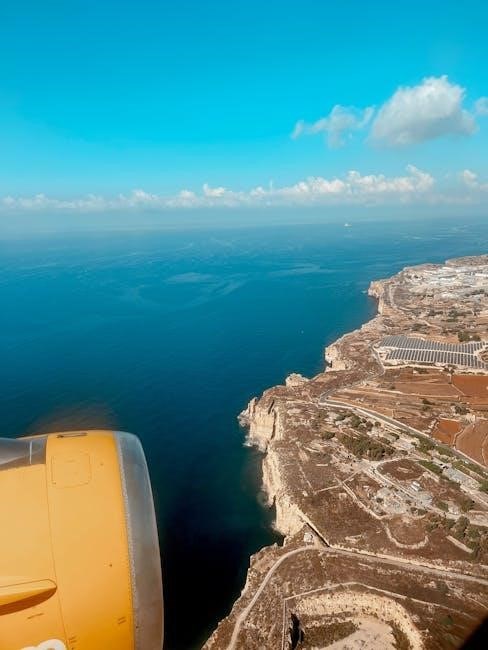Paul’s missionary journeys, spanning AD 47-58, mark the spread of Christianity beyond Jerusalem, beginning in Antioch and extending across Asia Minor, Greece, and Rome, shaping early Christianity․
1․1․ The Significance of Paul’s Missionary Work
Paul’s missionary work was pivotal in expanding Christianity beyond Jerusalem, establishing churches among Gentiles, and shaping the universal Church․ His journeys spread the Gospel to Asia Minor, Greece, and Rome, laying the foundation for Christian communities․ Paul’s teachings emphasized salvation through faith, uniting Jews and Gentiles under one faith․ Despite persecution, his work remains a cornerstone of Christianity, influencing doctrine and practice for centuries․ His legacy endures as a testament to the transformative power of the Gospel․
1․2․ Historical Context of Paul’s Journeys
Paul’s missionary journeys occurred during the Roman Empire’s reign under Emperor Claudius (AD 47-58), a period of relative stability․ Originating from Tarsus in Turkey, Paul, a Jewish Pharisee, was uniquely positioned to bridge Jewish and Gentile cultures․ His travels coincided with the early spread of Christianity, as the Church in Jerusalem faced persecution, prompting the dispersion of believers․ This historical backdrop facilitated Paul’s mission to establish churches across Asia Minor, Greece, and Rome, laying the groundwork for Christianity’s expansion beyond its Jewish roots․
1․3․ The Role of the Book of Acts in Documenting Paul’s Travels
The Book of Acts, written by Luke, provides the most detailed account of Paul’s missionary journeys․ It chronicles his conversion, preaching, and the establishment of churches, offering insights into his challenges and successes․ Acts serves as a historical and theological narrative, linking the early church’s growth to Paul’s efforts․ The text meticulously records key events, locations, and interactions, making it an indispensable source for understanding Paul’s travels and their significance in spreading Christianity across the Roman Empire․

The First Missionary Journey (AD 47-49)
Paul’s first journey began in Antioch, visiting Salamis, Paphos, and Perga, preaching the Gospel and establishing churches despite early persecution, laying the groundwork for future missions․
2․1․ The Journey Begins in Antioch
The church in Antioch, led by prophets and teachers, commissioned Paul and Barnabas to preach to Gentiles․ This marked the start of Paul’s missionary work, guided by the Holy Spirit․ Antioch became a hub for missionary endeavors, fostering a diverse community of believers․ The church’s support and spiritual leadership were instrumental in launching Paul’s journeys, setting a precedent for future missions․ This initial step in Antioch was pivotal in spreading Christianity beyond Jerusalem․
2․2․ Key Locations: Salamis, Paphos, and Perga
Paul and Barnabas began their mission in Salamis, preaching in synagogues to both Jews and Gentiles․ They then journeyed to Paphos, where they encountered resistance from Elymas, a sorcerer, but successfully converted the Roman governor Sergius Paulus․ From there, they traveled to Perga, where they preached the gospel, enduring challenges while establishing a foothold for Christianity in these regions․ These cities played crucial roles in spreading the gospel during the first missionary journey․
2․3․ The Preaching of the Gospel and Early Persecution
Paul and Barnabas faced significant opposition during their first journey․ They preached the gospel to both Jews and Gentiles, often in synagogues, leading to conversions and growing communities․ However, their success sparked persecution, particularly in Iconium and Lystra, where they were stoned and left for dead․ Despite these challenges, they continued to spread the message, establishing resilient churches that became foundational to early Christianity․ Their perseverance in the face of adversity underscored their unwavering commitment to their mission․

The Second Missionary Journey (AD 49-51)
Paul’s second journey focused on revisiting churches in Asia and Greece, strengthening their faith and spreading the gospel to new regions, despite facing persecution and challenges․
3․1․ Paul’s Return to Asia and Greece
Paul’s second missionary journey began with his return to Asia and Greece to strengthen existing churches and preach the gospel to new regions․ He revisited churches in Asia Minor, ensuring their spiritual growth and addressing challenges․ In Greece, he focused on ministry in Macedonia and Achaia, where he faced persecution but continued to spread the message of Christ․ This journey solidified his commitment to expanding Christianity and laid the groundwork for future missionary efforts across the Roman Empire․
3․2․ Ministry in Macedonia and Achaia
During his second journey, Paul ministered extensively in Macedonia and Achaia, preaching the Gospel and establishing churches․ In Macedonia, he faced persecution but continued to spread the message, while in Achaia, particularly in Corinth, his ministry flourished․ The region became a vital center for Christianity, with Corinth emerging as a key location where Paul spent significant time teaching and writing epistles that would later influence the early Christian communities and shape theological understanding․
3․3․ The Establishment of Churches in Corinth and Thessalonica
In Corinth, Paul’s ministry led to the founding of a vibrant church, despite initial opposition․ He spent 18 months there, influencing both Jews and Gentiles․ Similarly, in Thessalonica, Paul’s teachings laid the groundwork for a resilient church․ These communities became pivotal in spreading Christianity, with Corinth becoming a central hub and Thessalonica a beacon of faith․ Paul’s letters to these churches addressed their challenges and provided theological guidance, shaping their spiritual growth and enduring legacy in the early Christian world․

The Third Missionary Journey (AD 53-58)
Paul’s third journey focused on strengthening existing churches and extending his ministry to new regions, emphasizing deeper theological teaching and preparing communities for future challenges․
4․1․ Paul’s Extended Ministry in Ephesus
Paul’s extended ministry in Ephesus during his third journey was pivotal, lasting about two years․ He established a strong church and taught extensively, impacting Gentile communities deeply․ His teachings sparked both spiritual growth and opposition, notably the riot led by Demetrius, a silversmith, which highlighted the tension between Christianity and local traditions․ Despite challenges, Ephesus became a hub for Paul’s missionary efforts, solidifying its role in early Christianity․

4․2․ Visits to Galatia, Phrygia, and Other Regions

During his third journey, Paul visited Galatia and Phrygia, strengthening churches and preaching the Gospel․ He faced persecution but continued to spread Christianity, establishing vibrant communities․ These regions became crucial for the growth of the faith, showcasing Paul’s dedication to expanding the Church’s reach beyond Ephesus, ensuring a lasting impact on the early Christian movement across Asia Minor․
4․3․ The Impact of Paul’s Teaching on Gentile Communities
Paul’s teachings during his third journey profoundly influenced Gentile communities, emphasizing salvation through faith in Christ․ His ministry in Ephesus and surrounding regions led to widespread conversion, uniting Jewish and Gentile believers․ The establishment of self-sustaining churches demonstrated the universal nature of Christianity, paving the way for its expansion across the Roman Empire and leaving a lasting legacy in the early Christian world․
Paul’s Journey to Rome (AD 58-60)
Paul’s journey to Rome, marked by storms and a shipwreck, showcased his resilience․ Ministry in Malta, Sicily, and Italy highlighted his unwavering commitment to spreading the Gospel․
5․1․ The Voyage to Rome: Storms and Shipwreck
Paul’s journey to Rome was fraught with danger․ A violent storm, described as a tempest, battered the ship, putting all lives at risk․ Despite being a prisoner, Paul’s leadership shone as he urged calm and trust in God․ The ship eventually ran aground near Malta, where all passengers and crew miraculously survived․ This harrowing experience showcased Paul’s faith and resilience, even in the face of catastrophic events, solidifying his missionary resolve․
5․2․ Ministry in Malta, Sicily, and Italy
After the shipwreck, Paul ministered in Malta, healing the sick and preaching the Gospel․ The islanders’ kindness and openness to his message facilitated his work․ Moving onward, Paul traveled through Sicily and Italy, spreading Christianity․ His arrival in Rome marked the culmination of his journey, where he established a vibrant Christian community․ Despite being under house arrest, Paul continued to preach, further solidifying the roots of Christianity in the Roman Empire․
5․3․ Paul’s Final Imprisonment and Death
Paul was imprisoned in Rome, where he wrote several epistles, including Philippians, Philemon, and 2 Timothy․ Despite his confinement, he continued to preach and inspire believers․ After his release, he was rearrested and executed, likely by beheading, around AD 67-68․ His martyrdom in Rome marked the end of his earthly mission but cemented his legacy as a cornerstone of Christianity’s spread․
Paul’s final imprisonment and death symbolized his unwavering dedication to the Gospel, leaving behind a timeless impact on Christian doctrine and practice․
Key Events and Converts in Paul’s Journeys
Paul’s journeys were marked by transformative encounters, including the conversion of Sergius Paulus and his impactful ministry in Corinth, shaping early Christian communities across the Roman Empire․
6․1․ The Conversion of Sergius Paulus
During Paul’s first missionary journey, the conversion of Sergius Paulus, a Roman proconsul in Paphos, Cyprus, marked a pivotal moment․ Elymas, a sorcerer, opposed Paul, but Paul, filled with the Holy Spirit, confronted him, causing temporary blindness․ This demonstration of divine authority led Sergius Paulus to embrace Christianity, highlighting the power of the Gospel and the beginning of Paul’s successful ministry among Gentiles․
6․2․ The Ministry in Corinth and Its Significance
During his second missionary journey, Paul ministered in Corinth, a major Roman city in Greece, for approximately 18 months․ Despite facing persecution, he successfully established a vibrant church, which became a cornerstone of early Christianity․ Corinth’s strategic location facilitated the spread of the Gospel to surrounding regions․ Paul’s ministry here emphasized unity and resilience, addressing both Jews and Gentiles, and his epistles to the Corinthians remain foundational for Christian doctrine and practice․
6․3․ The Riot in Ephesus and Its Aftermath
In Ephesus, during Paul’s third missionary journey, his preaching against idolatry angered local silversmiths, who instigated a riot․ The commotion led to Paul’s eviction from the city․ This event, though disruptive, showcased the profound impact of Paul’s teachings on Gentile communities․ Despite the turmoil, the church in Ephesus flourished, and Paul’s influence remained strong․ This incident highlights the challenges he faced while spreading Christianity and his unwavering commitment to the Gospel, even in the face of adversity and opposition․

The Challenges and Persecutions Faced by Paul
Paul endured imprisonment, beatings, and constant threats due to his missionary work․ He faced fierce opposition from both Jews and Gentiles, including a plot in Jerusalem․
7․1․ Persecution in Antioch and Iconium
In Antioch and Iconium, Paul faced intense persecution․ Jewish leaders incited opposition, leading to his expulsion․ Despite this, he continued preaching in nearby Lystra and Derbe, undeterred by the hostility․ These challenges highlighted his unwavering commitment to spreading the Gospel, even in adversity․ The persecution became a testament to his faith, inspiring early Christian communities to remain steadfast, proving his resilience and dedication to his missionary work․
7․2․ The Philippian Jail and Miracle
During his second missionary journey, Paul and Silas were imprisoned in Philippi after casting out a spirit from a slave girl․ Despite being beaten and chained, they sang hymns, demonstrating unwavering faith․ A miraculous earthquake struck, breaking chains and opening doors, leading to their release․ This event showcased the power of prayer and trust in God, inspiring believers and highlighting Paul’s resilience in the face of adversity․ The miracle became a pivotal moment in his ministry․
7․3․ The Plot Against Paul in Jerusalem
In Jerusalem, Jewish leaders plotted against Paul, seeking to kill him due to his teachings․ Claudius Lysias, the Roman commander, discovered the conspiracy and intervened, rescuing Paul․ Bound by his Roman citizenship, Paul was taken to Caesarea, where he faced trial․ This event marked a turning point, as it led to Paul’s appeal to Caesar, initiating his journey to Rome․ The plot highlighted the intense opposition Paul faced and his reliance on Roman law for protection, ultimately advancing his missionary efforts to new regions․

The Theological Impact of Paul’s Journeys
Paul’s journeys expanded Christianity to Gentiles, establishing the church as a universal institution․ His teachings and epistles shaped Christian doctrine, emphasizing faith, grace, and unity in Christ;
8․1․ The Expansion of Christianity to Gentile Communities
Paul’s missionary journeys significantly expanded Christianity to Gentile communities, breaking cultural and religious barriers․ He preached in synagogues and public spaces, emphasizing salvation through faith in Christ․ This shift from a solely Jewish movement to a universal faith was revolutionary, establishing churches across Asia Minor, Greece, and beyond․ Paul’s teachings on grace and inclusion reshaped the early church, making Christianity accessible to all people, regardless of background․ His efforts laid the foundation for the global spread of the Gospel, transforming the Roman Empire and beyond․
8․2․ The Establishment of the Church as a Universal Institution
Paul’s missionary journeys played a pivotal role in establishing the church as a universal institution․ By preaching to Gentiles and Jews alike, he transcended cultural and religious boundaries, creating a unified body of believers․ His letters, such as Romans and Corinthians, emphasized unity and inclusivity, shaping the church’s identity as a global community․ This vision of Christianity as a universal faith, accessible to all, remains a cornerstone of the church’s mission today, reflecting Paul’s enduring legacy․
8․3․ The Role of Paul’s Epistles in Shaping Christian Doctrine
Paul’s epistles are foundational to Christian doctrine, addressing salvation, grace, and the church’s role․ Letters like Romans and Galatians articulated key theological concepts, such as justification by faith․ His writings provided guidance for early Christian communities, resolving conflicts and unifying believers․ These epistles not only shaped the theological framework of Christianity but also influenced its spread, offering timeless principles that continue to guide the church’s teachings and practices in the modern era․
Maps and Routes of Paul’s Missionary Journeys
Maps detail Paul’s travels across Asia Minor, Greece, and the Aegean, highlighting key stops like Antioch, Ephesus, Corinth, and Rome, tracing his missionary paths visually․
9․1․ Geographical Overview of the First Journey
Paul’s first missionary journey began in Antioch, proceeding to Cyprus, where he preached in Salamis and Paphos․ From there, he sailed to Asia Minor, visiting Perga in Pamphylia․ This journey marked the initial expansion of Christianity beyond Jewish communities, targeting Gentiles in regions like Cyprus and southern Asia Minor․ The route highlighted key cities and the challenges of early missionary work, laying the foundation for future endeavors․
9․2․ Detailed Routes of the Second and Third Journeys
Paul’s second journey (AD 49-51) began in Cilicia and Tarsus, revisiting Derbe and Lystra․ He traveled through Phrygia, Galatia, and Troas, entering Macedonia via Philippi, then to Thessalonica, Berea, Athens, and Corinth․ The third journey (AD 53-58) covered Galatia, Phrygia, and an extended stay in Ephesus, followed by Macedonia, Corinth, and a final trip to Jerusalem․ These routes emphasized strategic cities, fostering the spread of Christianity across diverse regions;
9․3․ The Journey to Rome and Its Significance
Paul’s journey to Rome (AD 58-60) began with his arrest in Jerusalem and transfer to Caesarea․ He appealed to Emperor Nero, leading to a voyage marked by a shipwreck near Malta․ After preaching in Malta, Sicily, and Italy, he reached Rome, where he was under house arrest for two years․ Despite imprisonment, Paul continued to spread the Gospel, influencing Roman officials and solidifying Christianity’s presence in the empire’s capital, leaving a lasting legacy for future generations․
The Spread of Christianity Through Paul’s Journeys
Paul’s missionary journeys established churches across Asia Minor, Greece, and Rome, transforming the Roman Empire into a hub for Christianity’s growth and universal influence․
10․1․ The Founding of Churches in Asia Minor
Paul’s missionary journeys led to the establishment of vibrant churches in Asia Minor, including Antioch, Salamis, Paphos, and Perga․ These churches became pivotal centers for spreading Christianity, blending Jewish and Gentile communities․ The teachings resonated deeply, fostering growth and unity among believers․ This foundational work laid the groundwork for the expansion of Christianity, leaving a lasting legacy in the region and beyond․ The impact of these early churches remains a cornerstone of Christian history and practice․
10․2․ The Influence of Paul’s Ministry in Greece
Paul’s ministry in Greece, particularly in Corinth and Thessalonica, significantly influenced the region’s spiritual landscape․ His teachings emphasized salvation through faith in Christ, attracting both Jews and Gentiles․ Despite facing persecution, Paul’s message resonated deeply, establishing thriving Christian communities․ The churches in Corinth and Thessalonica became vital centers for spreading Christianity, fostering a blend of cultural and theological practices․ Paul’s epistles to these communities continue to guide Christian doctrine, showcasing his enduring impact on Greece and beyond․
10․3․ The Legacy of Paul’s Work in the Roman Empire
Paul’s missionary efforts left a profound legacy in the Roman Empire, reshaping its spiritual and cultural landscape․ His teachings on grace, faith, and universal salvation resonated deeply, uniting diverse communities under a shared Christian identity․ The churches he established became centers of worship and learning, while his epistles provided theological foundations for the growing faith․ Paul’s vision of Christianity as a universal religion transcended cultural and social barriers, enduring long after his death and shaping the empire’s spiritual trajectory for centuries․
Paul’s missionary journeys profoundly shaped Christianity, spreading the Gospel across the Roman Empire and establishing enduring churches, leaving a legacy that continues to inspire and influence modern faith․
11․1․ The Enduring Legacy of Paul’s Missionary Work
Paul’s missionary work established foundational churches across the Roman Empire, fostering a universal Christian community․ His epistles remain central to Christian doctrine, guiding faith and practice for centuries․ Through persecution and perseverance, Paul’s teachings continue to inspire, demonstrating the transformative power of the Gospel․ His journeys not only expanded Christianity geographically but also deepened its theological understanding, leaving an indelible mark on global religion and culture․
11․2․ The Relevance of Paul’s Journeys in Modern Christianity
Paul’s missionary journeys exemplify adaptability and perseverance, offering timeless lessons for modern Christianity․ His ability to contextualize the Gospel across diverse cultures remains a model for global outreach․ The challenges he faced, including persecution and cultural barriers, resonate with contemporary issues, inspiring resilience and faith․ His teachings on unity, grace, and love continue to guide believers, making his journeys a cornerstone of modern Christian practice and evangelism․
11․3․ Final Thoughts on the Significance of Paul’s Travels
Paul’s journeys laid the foundation for Christianity’s global expansion, demonstrating courage, resilience, and a profound commitment to spreading the Gospel․ His travels, documented in Acts, reveal strategic evangelism and cultural adaptation․ Despite persecution, Paul’s unwavering faith and transformative teachings continue to inspire modern believers․ His legacy as a missionary and theologian remains unparalleled, shaping Christian doctrine and practice․ Paul’s life serves as a timeless example of dedication to God’s mission, leaving an enduring impact on the world․
